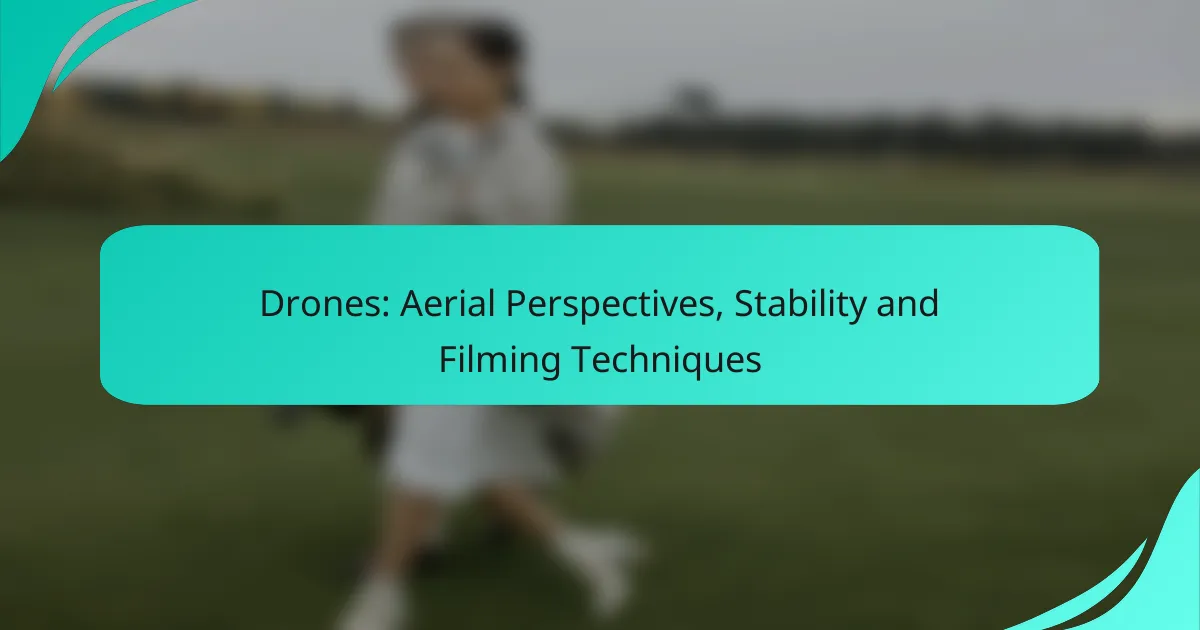Drones have revolutionized the way filmmakers capture aerial perspectives, offering unique vantage points that enhance storytelling and production quality. With advanced stabilization technology and precise flight control, these devices ensure smooth, professional-grade footage. By mastering specific movements and camera settings, filmmakers can elevate their aerial visuals and create captivating narratives.
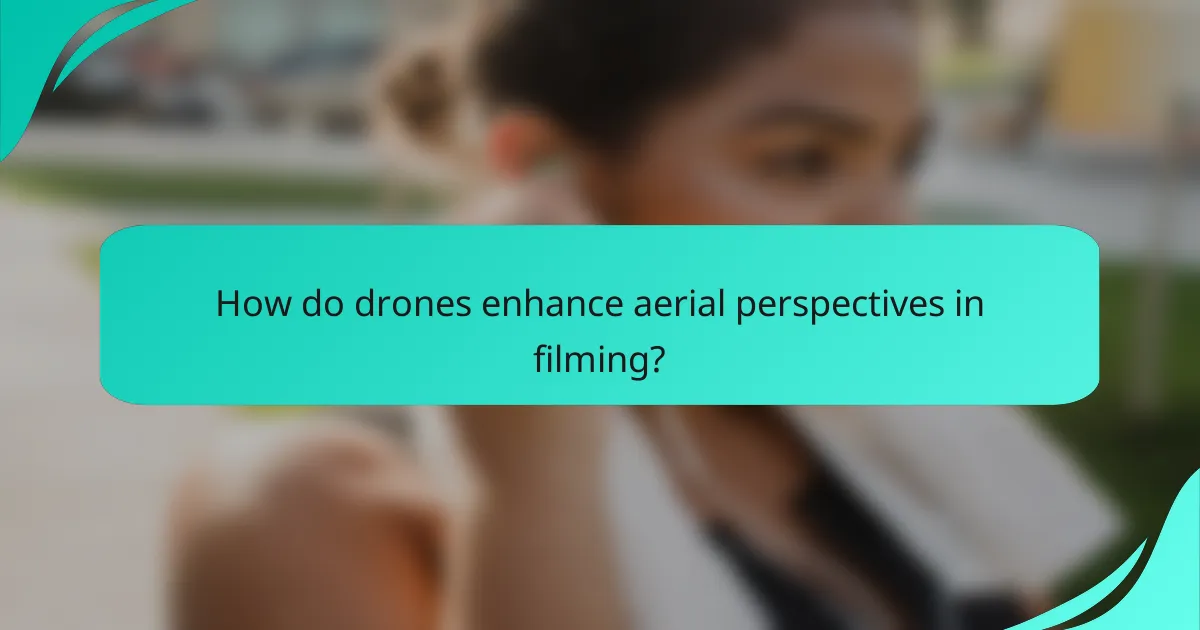
How do drones enhance aerial perspectives in filming?
Drones significantly enhance aerial perspectives in filming by providing unique vantage points that were previously difficult or impossible to achieve. Their ability to fly at various altitudes and angles allows filmmakers to capture stunning visuals that elevate storytelling and production quality.
Wide-angle lenses
Wide-angle lenses are essential for capturing expansive landscapes and dynamic scenes from a drone. These lenses allow for a broader field of view, making it easier to include more elements in the frame, which is particularly useful in outdoor settings like mountains or cityscapes.
When selecting a wide-angle lens for drone filming, consider options with a focal length of 14mm to 24mm. This range typically provides a good balance between distortion and field coverage, ensuring that the footage remains visually appealing.
High-resolution cameras
High-resolution cameras are crucial for producing sharp, detailed images that stand out in aerial footage. Drones equipped with cameras that offer 4K resolution or higher can capture intricate details, making the final product suitable for professional use.
When choosing a drone, look for models that support interchangeable lenses or have built-in high-resolution cameras. This flexibility allows filmmakers to adapt to different filming conditions and achieve the desired visual effects.
Stabilization technology
Stabilization technology is vital for ensuring smooth and steady footage during flight. Drones often utilize gimbals or electronic stabilization systems to counteract vibrations and sudden movements, resulting in professional-quality video.
For optimal results, select a drone with a 3-axis gimbal, which provides superior stabilization by controlling pitch, roll, and yaw. This feature is particularly important when filming in windy conditions or when performing complex maneuvers.
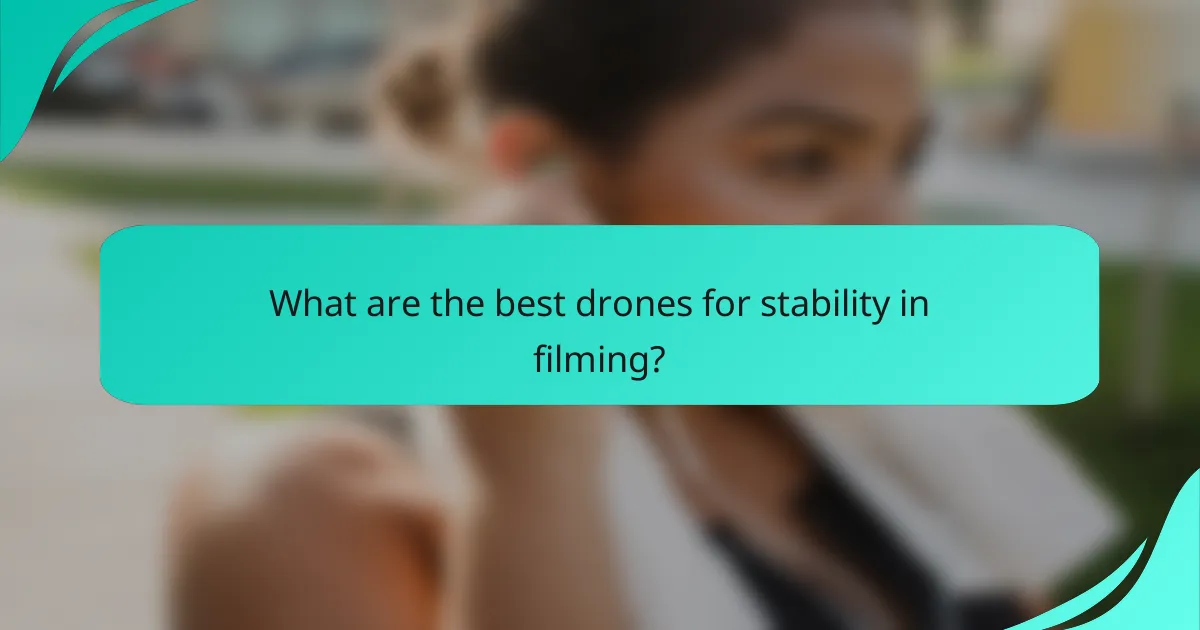
What are the best drones for stability in filming?
The best drones for stability in filming are designed to minimize vibrations and maintain a steady flight path, ensuring smooth footage. Key factors include advanced stabilization technology, flight control systems, and camera capabilities.
Dji Mavic 3
The Dji Mavic 3 is renowned for its exceptional stability, thanks to its advanced dual-camera system and omnidirectional obstacle sensing. It features a 4/3 CMOS Hasselblad camera that captures high-quality images and videos, making it ideal for professional filmmakers.
With a flight time of up to 46 minutes and a maximum transmission range of approximately 15 kilometers, the Mavic 3 allows for extended aerial shots without frequent landings. Its intelligent flight modes, such as ActiveTrack and Point of Interest, enhance filming capabilities while maintaining stability.
Autel Robotics EVO Lite+
The Autel Robotics EVO Lite+ offers impressive stability with its 1-inch CMOS sensor and advanced stabilization algorithms. This drone is capable of capturing 6K video at 30 frames per second, providing high-quality footage even in challenging conditions.
It boasts a flight time of around 40 minutes and features a robust GPS system for precise positioning. The EVO Lite+ also includes multiple shooting modes, such as HDR and time-lapse, which help filmmakers achieve creative shots while ensuring steady performance.
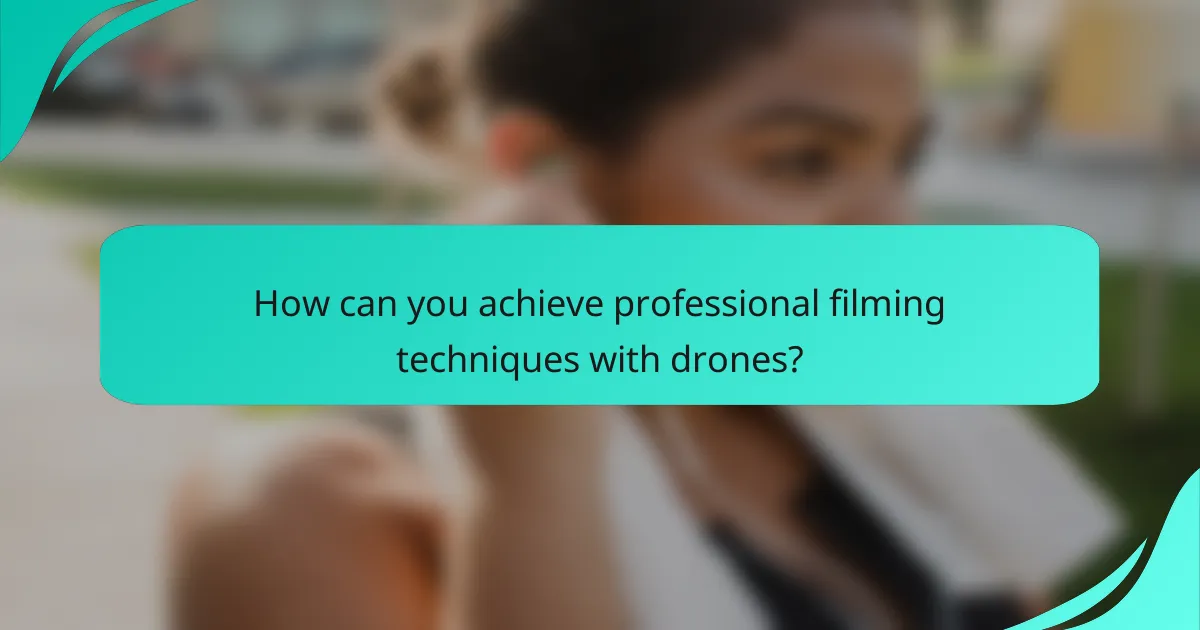
How can you achieve professional filming techniques with drones?
To achieve professional filming techniques with drones, focus on mastering specific movements and camera settings that enhance visual storytelling. Utilizing dynamic shots and creative filming techniques can significantly elevate the quality of your aerial footage.
Dynamic tracking shots
Dynamic tracking shots involve following a subject as it moves, creating a sense of motion and engagement in your footage. To execute this technique effectively, maintain a steady altitude and speed while adjusting the drone’s angle to keep the subject in frame.
Consider using a gimbal to stabilize the camera, reducing vibrations and ensuring smooth transitions. Practice varying your distance from the subject to add depth and perspective to your shots, which can enhance the overall cinematic feel.
Orbit and reveal techniques
Orbit and reveal techniques involve circling around a subject or slowly revealing it from behind an obstacle, adding drama and intrigue to your footage. For orbits, maintain a consistent radius and altitude, allowing the subject to remain centered in the frame while capturing a 360-degree view.
When using the reveal technique, start with the camera pointing at an object or landscape and gradually move the drone away or around it to unveil the scene. This method works well for landscapes, buildings, or events, providing viewers with a captivating perspective shift.
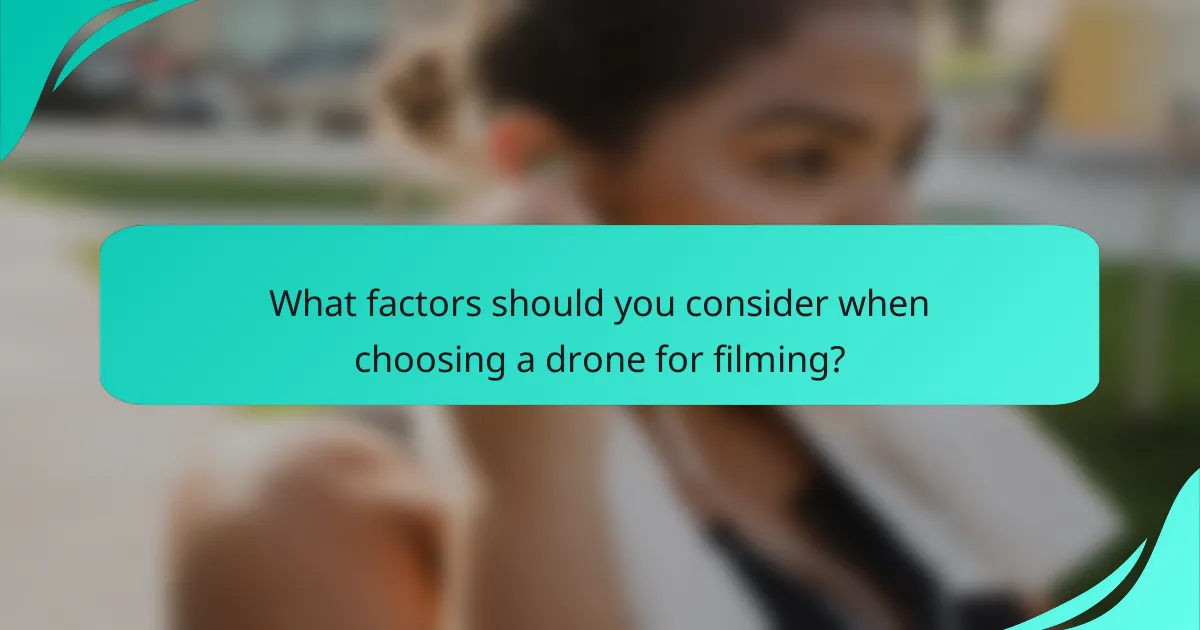
What factors should you consider when choosing a drone for filming?
When selecting a drone for filming, consider camera quality, flight time, and stability features. These factors significantly impact the overall filming experience and the quality of the footage captured.
Camera quality
Camera quality is crucial for achieving professional-looking footage. Look for drones equipped with high-resolution cameras, ideally 4K or higher, to ensure sharp images and vibrant colors. Additionally, consider the sensor size and lens options, as these can greatly affect low-light performance and depth of field.
Some drones offer interchangeable lenses, allowing for greater creative flexibility. If you plan to shoot in various environments, a drone with a gimbal stabilization system will help maintain smooth footage, even in windy conditions.
Flight time
Flight time directly affects how much footage you can capture in a single session. Most consumer drones offer flight times ranging from 20 to 30 minutes on a full charge. Keep in mind that factors such as wind conditions and camera usage can reduce this time.
To maximize your filming opportunities, consider purchasing extra batteries or a drone with a longer flight time. This way, you can minimize downtime and capture more content during your shoots.
Stability features
Stability features are essential for producing smooth and professional footage. Look for drones that include advanced stabilization technologies, such as GPS positioning and altitude hold, which help maintain a steady flight path. These features are particularly important when filming in challenging conditions or at high altitudes.
Additionally, consider drones that come with obstacle avoidance systems. These systems can prevent crashes and allow you to focus on capturing great shots without worrying about potential hazards in the environment.
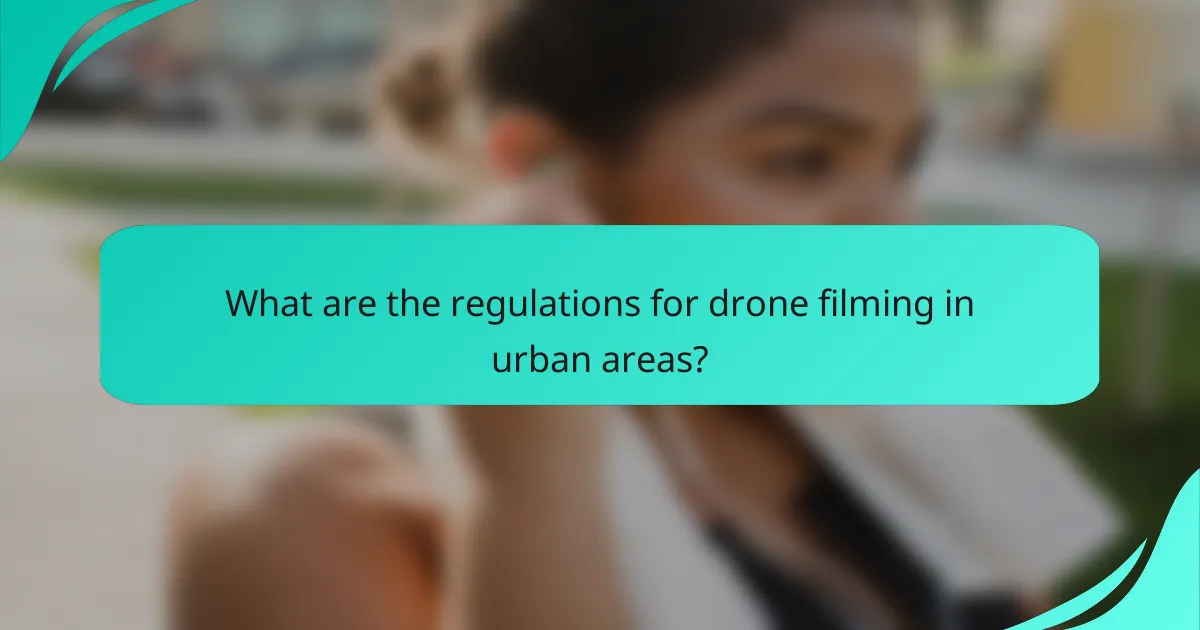
What are the regulations for drone filming in urban areas?
Drone filming in urban areas is subject to specific regulations that ensure safety and privacy. Operators must adhere to both federal guidelines and local laws to avoid penalties and ensure responsible use.
FAA guidelines
The Federal Aviation Administration (FAA) sets forth essential guidelines for drone operation, which include maintaining a maximum altitude of 400 feet and keeping the drone within visual line of sight. Filming for commercial purposes requires a Part 107 certification, which mandates passing an aeronautical knowledge test.
Additionally, drone operators must avoid flying near airports, emergency response efforts, and crowded areas unless they have special permissions. Compliance with these regulations is crucial for safe and legal drone operations.
Local restrictions
Local restrictions can vary significantly by city or municipality, often including no-fly zones over parks, schools, and residential areas. Some cities may require permits for drone filming, especially in public spaces, to protect privacy and minimize disturbances.
Before filming, it’s advisable to check local ordinances and obtain any necessary permits. Failing to comply with local laws can result in fines or confiscation of equipment, so thorough research is essential for successful drone operations in urban environments.
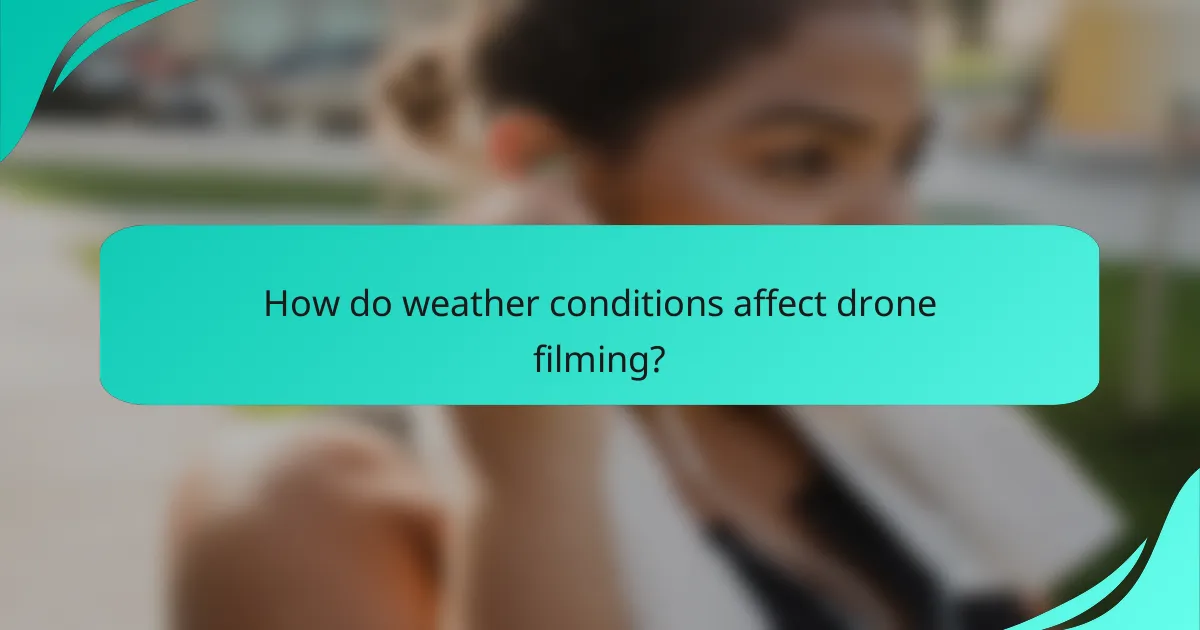
How do weather conditions affect drone filming?
Weather conditions significantly influence drone filming by impacting stability, visibility, and overall image quality. Factors such as wind, rain, and lighting can either enhance or hinder the filming experience, making it essential for operators to assess these elements before flying.
Wind impact on stability
Wind is one of the most critical weather factors affecting drone stability. Strong winds can cause drones to drift or lose control, especially smaller models that are more susceptible to gusts. For safe operation, it’s advisable to avoid flying in winds exceeding 15-20 mph, particularly for lightweight drones.
When planning a shoot, consider checking local weather forecasts and using an anemometer to measure wind speed at your filming location. If winds are inconsistent or gusty, it may be best to postpone the flight to ensure stable footage.
Lighting conditions
Lighting conditions play a vital role in the quality of drone footage. Bright sunlight can create harsh shadows and overexposed highlights, while low light can result in grainy images. The golden hour, shortly after sunrise or before sunset, often provides the best lighting for filming, offering softer shadows and warmer tones.
To optimize lighting, consider using ND filters to reduce glare and enhance color saturation. Always assess the sun’s position relative to your subject to avoid backlighting, which can obscure details. Adjusting camera settings for different lighting scenarios can also help achieve the desired visual effect.
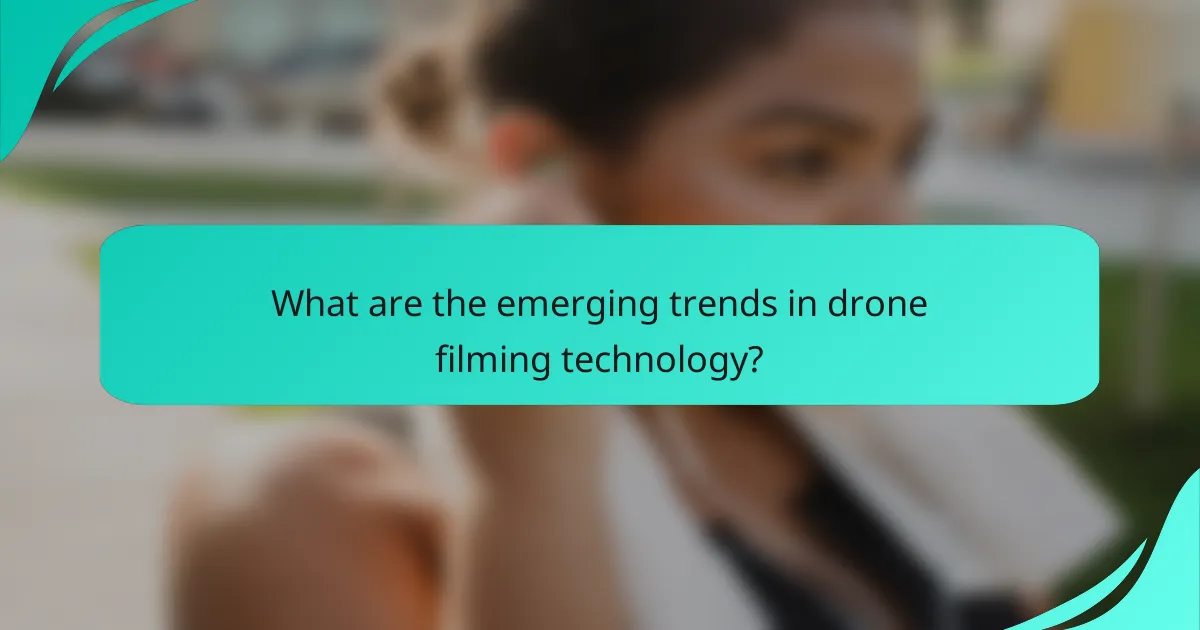
What are the emerging trends in drone filming technology?
Emerging trends in drone filming technology focus on enhanced stability, improved camera capabilities, and advanced automation features. These innovations are making aerial filming more accessible and efficient for both professionals and enthusiasts.
Improved stabilization systems
Modern drones are equipped with advanced stabilization systems that significantly reduce vibrations and jerky movements during flight. These systems often utilize gimbals and electronic stabilization to ensure smooth footage, even in windy conditions.
For example, drones with 3-axis gimbals can maintain camera orientation regardless of drone movement, providing a cinematic quality to the footage. When selecting a drone, consider models that feature these stabilization technologies for the best results.
Higher resolution cameras
Many new drones come with high-resolution cameras capable of capturing 4K and even 8K video. This trend allows filmmakers to produce stunning visuals with greater detail and clarity, making it easier to create professional-quality content.
When choosing a drone, look for those that offer interchangeable lenses or larger sensors, as these features can enhance image quality and versatility. Additionally, consider the bitrate and compression formats used, as they can affect the final output quality.
Automated flight modes
Automated flight modes are becoming increasingly popular, allowing users to capture complex shots with minimal effort. Features like waypoint navigation, follow-me modes, and orbiting capabilities enable drones to execute intricate maneuvers autonomously.
These automated features can save time and reduce the learning curve for new users. However, it’s crucial to familiarize yourself with the drone’s capabilities and limitations to avoid potential mishaps during filming.
